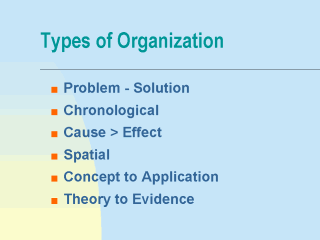| front |1 |2 |3 |4 |5 |6 |7 |8 |9 |10 |11 |12 |13 |14 |15 |16 |17 |18 |19 |20 |21 |22 |23 |24 |25 |review |
 |
Presenting the
objectives of the lecture and giving students an idea of the approach that you are going
to take allows them to organize the material better in their own minds. Students tend to
learn more easily when they see how new information is organized and structured. This
general organization can be demonstrated verbally, in an outline, or in some other manner
that lets learners know what to expect. Your lecture can be organized around different schemes: Problem-Solution - Begins by presenting a problem, explaining its significance, and then offering a solution. Chronological - Lists events as they naturally occur. Cause > Effect - Begins by describing some type of event, the cause of the event, and the effects. Spatial - Discusses things as they occur in space. Concept to Application - Describes a concept and then illustrates how that concept can be applied to different situations. Theory to Evidence - Presents a theory, and then the supporting evidence towards that theory. Often, the scheme can be determined by the context of the information that you are presenting. |
| front |1 |2 |3 |4 |5 |6 |7 |8 |9 |10 |11 |12 |13 |14 |15 |16 |17 |18 |19 |20 |21 |22 |23 |24 |25 |review |